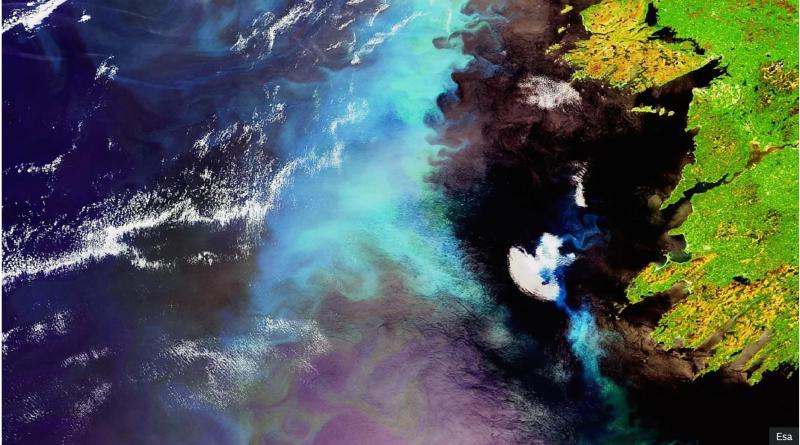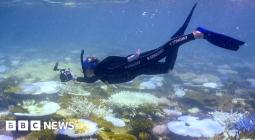Why the world's oceans are changing colour

The balance of phytoplankton populations in the sea is shifting as a result of human-induced climate change, altering the oceans in profound ways.
When you picture the ocean you might imagine sparkling turquoise waters – but recent research suggests swathes of our world's oceans may in fact be turning greener. And the leading culprit might be climate change.
And while some waters are becoming more green, particularly in low latitudes near the equator, others are growing more blue as global temperatures rise.
Although this shift in colour isn't visible to the naked eye, satellite studies are able to map the change.
"The colour itself is not something that's easy to describe with human language or that you can even see that well," says B B Cael, a scientist at the National Oceanography Centre in Southampton in the UK. Instead, this might be something that a mantis shrimp or a butterfly could see, he adds.
The recent European State of the Climate report, published in April 2024 by the European Union's Copernicus Climate Service, revealed just how much change is taking place in the ocean. It found that chlorophyll – a photosythetic pigment found in phytoplankton and plants that gives them their green hue – were 200-500% higher than average in the Norwegian sea and Altantic Ocean north of the UK in April 2023, while they were 60-80% lower in the ocean west of the Iberian Peninsula. The Mediterranean Sea saw chorophyll levels 50-100% higher than average in June 2023. In both cases the average was taken from measurements between 1998-2020.
Scientists believe these shifts in colour go beyond natural year-to-year variations and are a sign of warming ocean temperatures. (Read about the impacts of record ocean heat.)
It comes as analysis by BBC News of sea surface temperatures collected by Copernicus has revealed the world's oceans are experiencing record warming. It showed that temperature records were broken in the world's oceans every day over the past year.
Cael is the lead author on a recent study published in Nature, which mapped two decades of data using Nasa satellites.
Alongside scientists from Massachusetts Institute of Technology (MIT), he found that more than half the world's ocean area – 56% – changed colour. To put this into perspective, this area is larger than all of the world's landmass.
The role of phytoplankton
Although scientists aren't sure about the exact causes of these changes, they believe the mass and spread of phytoplankton plays a huge part.
Phytoplankton are microscopic, photosynthesising organisms which form the base of the marine food web, sustaining other organisms further up the food chain from krill to whales. They contain chlorophyll, the same green pigment that plants use to harvest energy from sunlight when photosynthesising. Phytoplankton also play a large part in transferring carbon dioxide from the atmosphere to the ocean.
Typically, the ocean's colour is a result of what lies within its upper layers. In the open ocean, this is the phytoplankton ecosystem. Waters that are deep blue contain less life, while greener waters signal the presence of more phytoplankton.
By studying the wavelengths of sunlight reflected off the ocean's surface, scientists can estimate how much chlorophyll is present. "Different phytoplankton have different combinations of pigments used to photosynthesise. These pigments absorb light at different wavelengths," says Cael.
"A glass of water with red food dye looks red because there's something in it that absorbs non-red wavelengths. Phytoplankton, because they are particles in the water, scatter light," he adds.
'Virtual Earth'
Modis, an instrument on Nasa's Aqua satellite, takes measurements in seven visible wavelengths, which is a fuller colour spectrum than was captured in previous studies based on computer models.
With this, Cael created a model to run simulations. "We have a virtual Earth where we can have two different versions of history. In one case, we don't have climate change. In the other case, we do," he says.
To map the spectrum of colour changes, Cael drew from 20 years of data from an instrument onboard Nasa's Aqua satellite, known as the Modis (Moderate Resolution Imaging Spectroradiometer) data.
Modis takes measurements in seven visible wavelengths, which is a fuller colour spectrum than was captured in previous studies.
With this, Cael created a model to run simulations. "We have a virtual Earth where we can have two different versions of history. In one case, we don't have climate change. In the other case, we do," he says.
"We can look at how those two virtual Earths diverge over time and what we see there is something similar to what we're seeing in the real ocean," Cael adds. It was this experiment which discovered that the colours in 56% of the world's oceans had changed. In particular, tropical ocean regions near the Equator have become steadily greener over time, because of the added chlorophyll from increasing phytoplankton.
"We're seeing changes in all the major ocean basins – it's not confined to just the Pacific or Atlantic or Indian [oceans]. These are really global scale changes that we're seeing," says Cael.
This confirms a theory in an earlier paper from Stephanie Dutkiewicz, an oceans scientist in MIT and the Center for Global Change Science.
In 2019, Dutkiewicz used computer models to predict future changes in ocean colour. However, it was hard to determine whether this was due to climate change or normal oceanic patterns, such as those observed during El Niño and La Niña.
"The natural variability is very large. So whether this is increasing or decreasing due to climate change was quite difficult to tell," says Dutkiewicz.
Cael's study, which added satellite data, widened the scope beyond chlorophyll, looking at different wavelengths, including red and blue, as light bounces off the particles and sediment. Dutkiewicz, who also worked on Cael's study, says the recent paper confirmed her statistical predictions.
"The real-world satellite measurements are consistent with what is seen in the model," she says. "So by inference, the changes we're seeing in the real world are very likely due to human-induced changes to the climate."
The impact these changes will have on the ocean are likely to be dramatic. Some researchers have predicted that phytoplankton will shift north at a speed of around 35km (21 miles) each decade as tempteruares continue to warm. This will lead to changes in the distribution of zooplankton – the tiny animals that feed on the phytoplankton – too, with species richness expected to decline in the tropics and increase dramatically in temperate and subpolar waters, leading to further knock on effects in the interconnected food webs and fish that rely upon these creatures.
Emerald coves and deep blue open stretches of sea won't suddenly change colour overnight. But the changes reveal a trend that may increase as temperatures warm.
"It's not really the colour itself that we care about," says Cael. "What matters is the change in colour reflects the change in the ecosystem."




